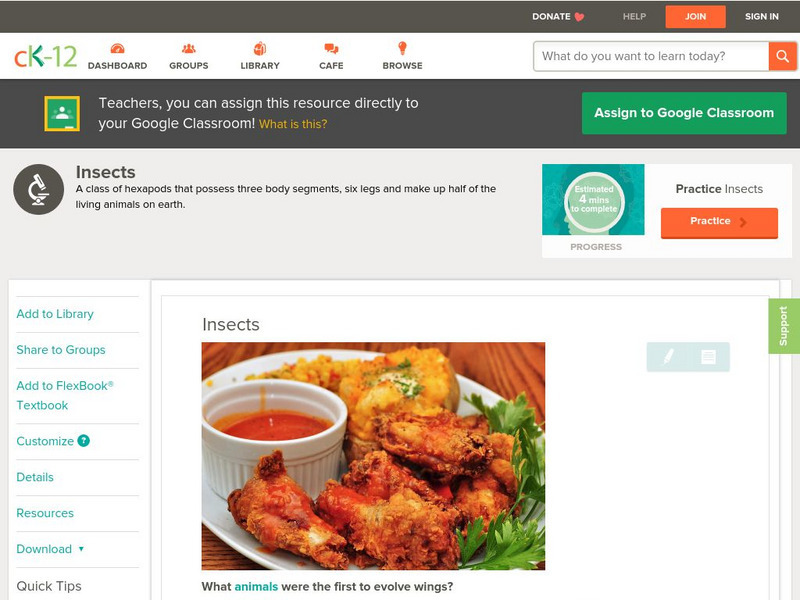Curated OER
Dinner in a Woodland
After reading a short paragraph about what makes up a woodland habitat, fifth graders attempt to identify the primary consumers, secondary consumers, and third order consumers in two separate food chain scenarios. They also name a hawk's...
Kenan Fellows
Use of Dichotomous Keys to Identify Stream Organisms
What kind of organisms are living in the stream? After an explanation on how to use a dichotomous key, groups of three to four use the keys to identify macroinvertebrates from a local freshwater stream. Using the the concept of Stream...
American Museum of Natural History
Create Your Own Time Capsule
The corona virus pandemic is indeed a historic event. A time capsule activity permits young historians to document these days of social distancing, remote learning, and quarantine by collecting artifacts that capture what their lives are...
Curated OER
Note Taking
Second graders work in groups to gather information from a factual paragraph on the topic of ants. They demonstrate taking notes by selecting 3 or 4 important key words in each sentence and write it on a note card to compile summary...
Curated OER
School Yard Park/ Ecosystem
Fifth graders examine ecosystems in their schoolyard. In this nature and ecosystem lesson, 5th graders map their schoolyard into workable plots. They classify plants and animals found in the plot. They revisit their site every two weeks...
Curated OER
Mutualism and Co-evolution A study of Flowering Plants and their Pollinators: Biology, Plants
These lessons use a variety of methods and approaches to teach flowering plant biology which includes seed germination; plant growth and food production through photosynthesis; plant transpiration and respiration; sexual reproduction...
Curated OER
The Great Pollinators
Students discover the reproductive parts of a plant. In this biology instructional activity, students identify and categorize several different plants they dissect in class. Students record their information using a data chart.
Curated OER
Classification of Cerealites
Students create a dichotomous key. In this categorizing lesson, students create a dichotomous key for different types of cereal. Students classify the cereal into groups such as flakes and cereal with holes. Students discuss their...
Curated OER
Animals Finding Rice Paddies
Fourth graders examine the animals who live in rice paddies and create a chart. For this rice lesson, 4th graders link the types of animals living in each ecosystem with a bar graph. Students use colored bars to show animals that live...
Curated OER
Investigating comparative biodiversity of wetland and schoolyard sites
Fourth graders participate in an activity dealing with the environment.
Curated OER
The Buzz on Bees-How Bees Make Our World a Little Sweeter
These lessons can help students learn about the important role bees play in the ecosystem.
Curated OER
Radial Design Mandala
Students design original radial art designs.In this radial design lesson, students use compasses and a nature inspired idea to create radial art. Students understand the use of symmetry, balance and design shapes in continual patterns....
Curated OER
Animal Poetry
In this animal poetry worksheet, students gather information about an animal and follow a sample to write an animal poem. Page has links to additional activities.
CK-12 Foundation
Ck 12: Third Grade Science: Life Science: Insect Reproduction and Life Cycles
[Free Registration/Login may be required to access all resource tools.] Compares and contrasts the major stages in insect life cycles, such as those that undergo incomplete and complete metamorphosis.
CK-12 Foundation
Ck 12: Life Science: Insect Reproduction and Life Cycle
[Free Registration/Login may be required to access all resource tools.] Most insects can reproduce quickly within a short period of time, which means they evolve faster and can adjust to environmental changes. Most reproduce by sexual...
CK-12 Foundation
Ck 12: Life Science: Insects
[Free Registration/Login may be required to access all resource tools.] Insects, with over a million described species, are the most diverse group of animals on Earth. They may be found in nearly all environments on the planet. No matter...
CK-12 Foundation
Ck 12: Life Science: Insect Food
[Free Registration/Login may be required to access all resource tools.] Insects have different types of appendages adapted for capturing and feeding on prey. They also have special senses that help them detect prey. Furthermore, insects...
CK-12 Foundation
Ck 12: Life Science: 9.18 Importance of Insects
Understand the ecological importance of insects, and why they are important to humans.
CK-12 Foundation
Ck 12: Life Science: 9.15 Insects
Understand the behaviors, characteristics, and classification of insects.
CK-12 Foundation
Ck 12: Life Science: 9.16 Insect Food
See how insects get food, and what they eat to survive.
CK-12 Foundation
Ck 12: Life Science: 9.19 Insect Control
Learn about the different chemical and biological insect control methods.
CK-12 Foundation
Ck 12: Life Science: 9.14 Importance of Arthropods
Understand the behaviors, characteristics, and classification of arthropods.
CK-12 Foundation
Ck 12: Life Science: 9.10 Arthropods
Explore the behaviors, characteristics, and diversity of arthropods.
CK-12 Foundation
Ck 12: Life Science: 9.1 Invertebrate Diversity
Understand the biological diversity and classification of invertebrates.


















